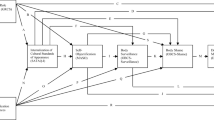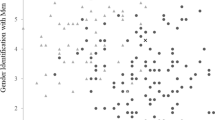Abstract
The interactive effects of gender role typing and adherence to a superwoman ideal (desiring to excel in many diverse roles) on the potential for disordered eating were examined among a nonclinical sample of women. Results indicated that both masculine and feminine gender-typed women who strongly adhered to a superwoman ideal were at greater risk for eating disorders than androgynous superwomen. In contrast, androgynous superwomen had relatively low potential for disordered eating and appeared comparable to women who, regardless of gender typing, rejected the superwoman ideal. Women undifferentiated with regard to gender type, whether superwomen or not, also had reduced potential for disordered eating. Findings are discussed with regard to gender role socialization and expectations, and the implications for mediating the potential for eating disorders are considered.
Similar content being viewed by others
References
Barnett, L. R. (1986). Bulimarexia as symptom of sex-role strain in professional women. Psychotherapy: Theory, Practice, and Research, 23, 311–315.
Beller, A. S. (1977). Fat and thin: A natural history of obesity. New York: Farrar, Straus, and Giroux.
Bem, S. L. (1975). Sex role adaptability: One consequence of psychological androgyny. Journal of Personality and Social Psychology, 31, 634–643.
Bem, S. L. (1977). On the utility of alternative procedures for assessing psychological androgyny. Journal of Consulting and Clinical Psychology, 45, 196–205.
Bem, S. L. (1981). Gender schema theory: A cognitive account of sex typing. Psychological Review, 88, 354–364.
Bem, S. L., & Lenney, E. (1976). Sex typing and the avoidance of cross-sex behavior. Journal of Personality and Social Psychology, 33, 48–54.
Emmett, S. W. (1985). Future trends. In S. W. Emmett (Ed.), Theory and treatment of anorexia nervosa and bulimia: Biomedical, sociocultural, and psychological perspectives. New York: Brunner/Mazel.
Fallon, A. E., & Rozin, P. (1985). Sex differences in perceptions of desirable body shape. Journal of Abnormal Psychology, 94, 102–105.
Fenigstein, A., Scheier, M., & Buss, A. (1975). Public and private self-consciousness: Assessment and theory. Journal of Consulting and Clinical Psychology, 43, 522–527.
Garfinkel, P. E., & Garner, D. M. (1982). Anorexia nervosa: A multidimensional perspective. New York: Brunner/Mazel.
Garner, D. M., Olmstead, M. P., & Polivy, J. (1983). Development and validation of a multidimensional eating disorder inventory for anorexia nervosa and bulimia. International Journal of Eating Disorders, 2, 15–34.
Hart, E. A., Leary, M. R., & Rejeski, W. J. (1989). The measurement of social physique anxiety. Journal of Sport and Exercise Psychology, 11, 94–104.
Helmreich, R. L., Spence, J. T., & Holahan, C. K. (1979). Psychological androgyny and sex role flexibility: A test of two hypotheses. Journal of Personality and Social Psychology, 37, 1631–1644.
Herman, C. P., & Polivy, H. (1980). Restrained eating. In A. Stunkard (Ed.), Obesity. Philadelphia, PA: W. B. Saunders.
Hsu, L. K. G. (1990). Eating disorders. New York: Guilford Press.
Katzman, M. A., & Wolchik, S. A. (1984). Bulimia and binge eating in college women: A comparison of personality and behavioral characteristics. Journal of Consulting and Clinical Psychology, 52, 523–428.
Lewis, L. D., & Johnson, C. (1985). A comparison of sex role orientation between women with bulimia and normal controls. International Journal of Eating Disorders, 4, 247–257.
Linville, P. W. (1985). Self-complexity and affective extrenity: Don't put all of your eggs in one cognitive basket. Social Cognition, 3, 94–120.
McBride, A. B. (1990). Mental health effects of women's multiple roles. American Psychologist, 45, 381–384.
Orbach, S. (1978). Fat is a feminist issue: The anti-diet guide to permanent weight loss. New York: Paddington Press.
Orbach, S. (1986). Hunger strike: The anorectic's struggle as a metaphor for our age. New York: Norton.
Palazzoli, M. S. (1978). Self-starvation: From individual to family therapy in the treatment of anorexia nervosa. New York: Jason Aronson.
Pliner, P., Chaiken, S., & Flett, G. L. (1990). Gender differences in concern with body weight and physical appearance over the life span. Personality and Social Psychology Bulletin, 16, 263–273.
Polivy, J., Garner, D. M., & Garfinkel, P. E. (1986). Causes and consequences of the current preference for thin female physiques. In C. P. Herman, M. P. Zanna, & E. T. Higgins (Eds.), Physical appearance, stigma, and social behavior: The Ontario symposium (Vol. 3). Hillsdale, NJ: Lawrence Erlbaum.
Polivy, J., & Herman, C. P. (1983). Breaking the diet habit. New York: Basic Books.
Root, P. P. (1990). Disordered eating in women of color. Sex Roles, 22, 525–536.
Rosenberg, M. (1965). Society and the adolescent self-image. Princeton, NJ: Princeton University Press.
Ryckman, R. M., Robbins, M. A., Thornton, B., & Cantrell, P. (1982). The development and validation of a physical self-efficacy scale. Journal of Personality and Social Psychology, 42, 891–900.
Schwartz, D. M., Thompson, M. G., & Johnson, C. L. (1985). Anorexia nervosa and bulimia: The sociocultural context. In S. W. Emmett (Ed.), Theory and treatment of anorexia nervosa and bulimia: Biomedical, sociocultural, and psychological perspectives. New York: Brunner/Mazel.
Selvini-Palazzoli, M. (1974). Self-starvation: From the intrapsychic to the transpersonal approach to anorexia nervosa. London: Chaucer Publishing.
Sitnick, T., & Katz, J. L. (1984). Sex role identity and anorexia nervosa. International Journal of Eating Disorders, 3, 81–87.
Spence, J. T., & Helmreich, R. L. (1978). Masculinity and femininity: Their psychological dimensions, correlates, and antecedents. Austin: University of Texas Press.
Spence, J. T., & Helmreich, R. L. (1980). Masculine instrumentality and feminine expressiveness: Their relationship with sex-role attitudes and behavior. Psychology of Women Quarterly, 5, 147–163.
Steiner-Adair, C. (1986). The body politic: Normal female adolescent development and the development of eating disorders. Journal of the American Academy of Psychoanalysis, 14, 95–114.
Timko, C., Striegel-Moore, R. H., Silberstein, L. R., & Rodin, J. (1987). Femininity/masculinity and disordered eating in women: How are they related? International Journal of Eating Disorders, 6, 701–712.
Author information
Authors and Affiliations
Rights and permissions
About this article
Cite this article
Thornton, B., Leo, R. & Alberg, K. Gender role typing, the superwoman ideal, and the potential for eating disorders. Sex Roles 25, 469–484 (1991). https://doi.org/10.1007/BF00292535
Issue Date:
DOI: https://doi.org/10.1007/BF00292535




